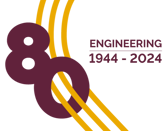
Article by Engela Duvenage
South Africa’s SA Agulhas II polar supply and research vessel has returned from its annual winter cruise to the Southern Ocean (SCALE). Four engineering students from Stellenbosch University were on board, along with a group of SU earth sciences students and researchers from other institutions. The engineering students investigate the vessel itself, and how those on board experienced its passage through the icy seas.
Armand van Zuydam of East London, Nicole Taylor of Stellenbosch, Martinique Engelbrecht of Concordia in the Northern Cape and Jesslyn Bossau of Windhoek in Namibia are working towards masters degrees in mechanical or mechatronic engineering. They are part of the Sound and Vibration Research Group of the SU Department of Mechanical and Mechatronic Engineering,
The three weeks on board the SA Agulhas II afforded them the opportunity to experience the ice landscape of the Antarctic region, to learn from researchers of different nationalities on board, and to experience the professionalism and service of the SA Agulhas II crew.
Martinique Engelbrecht, a member of the Maties Women’s Cricket Team, made do with snowballs to fulfill her dream of playing cricket in the Southern Ocean. Nicole Taylor often thought about her grandfather, Constant McLachlan, who regularly travelled to the polar region to do construction work on South Africa’s bases in Antarctica and its research islands.
“I wondered if he perhaps also felt the same excitement when he saw the ice for the first time, or saw his first swimming penguin,” Taylor says.
“The power of the waves made me feel quite small,” says Jesslyn Bossau, who was wowed by the different moods of the ocean, the everchanging ice landscapes and the sunsets.
Importantly, their time on board afforded the four engineering students the chance to experience the to’s and fro’s of the SA Agulhas II firsthand – and to even get seasick in the process! They are studying how the SA Agulhas II responds to the slamming of waves as it navigates rough seas and ice towards the polar regions.
“We conducted full-scale measurements using accelerometers placed on the ship and investigated under which wave states the vessel experiences wave slamming. These incidences were rated according to the level of discomfort passengers suffered. They also filled in daily motion sickness and slamming surveys,” explained Armand van Zuydam. “With an acoustic dummy dubbed Mike, we measure the sounds experienced in cabins.”
The students’ work is part of an ongoing monitoring project since 2012 which started when the then newly built SA Agulhas II undertook its first ice tests in the Baltic Sea. Stellenbosch University has been part of the research project since its inception and continues the work in conjunction with Aalto University in Finland. The research is funded by South Africa’s National Research Foundation, and the Academy of Finland.
Prof Annie Bekker, director of the Sound and Vibration Research Group of the SU Department of Mechanical and Mechatronic Engineering, says the SA Agulhas II is currently the only polar supply and research vessel travelling on the world’s icy oceans being monitored in such great detail. She hopes that their research will go far to help develop systems with which to better monitor and predict how ships and their passengers respond to different conditions.
All information gathered over the past seven years is open source, and is much more comprehensive than available commercial data.
“The Department of Environmental Affairs and the South African National Antarctic Programme (SANAP) enables our research through availing berth space and crew support which is crucial to the success of this project,” adds Prof Bekker.
“The SAA II was the first vessel in her class to be built according to a set of international SOLAS rules from 2009 about the safety and comfort of passenger ships. As such her design provides valuable operational experience towards the commissioning of other polar supply and research vessels by other countries,” Prof Bekker wrote in a recent article she was the lead author of in the journal Ship Technology Research. “In a world where climatic changes are probable, and where the prediction of such changes relies greatly on knowledge and understanding of the ocean, the SAA II is strategic as a world-class research platform.”
Prof Bekker’s team have over the past few years already measured aspects such as the pressure of the ice, and the resulting force it has on the ship’s hull and propulsion system, ice-induced structural vibrations and noise, whole-body vibration comfort, ship dynamics in ice, global ice loads, underwater noise and mechanical and physical sea ice properties.
“We have been able to ‘colour in a more complete picture’ about the environments that really challenge the SA Agulhas II,” explains Prof Bekker.
She says the vessel is masterfully designed for ice operations, has a maximally strengthened hull and is well-protected against local hull damage.
“We do however see that the propulsion system operates very close to her design limit. It will be a priority to add live monitoring to alert the ship crew about risky operations,” she notes.
Her team’s data show that the ship only spends about 15% of a conventional Antarctic relief voyage in ice. The majority of her time is spent in the Southern Ocean where storms and high waves swells are prevalent.
According to Bekker, it is important to investigate the impact that the vessel’s ice-going design has on how well she performs in open water and waves. Current data available to the SU team shows that the ship hull bends the most when she is navigated through high seas.
“That’s why the SCALE winter voyage was of such value to our team. For the passengers it was not fun to be rolled around in their beds or have their tables shift away from them, but for my students the rough weather provided ideal conditions in which to measure how the ship and the people on board respond to these conditions,” remarks Bekker.
Human ‘digital’ twins
As part of her masters thesis, Nicole Taylor is developing a human digital twin for passengers on board a polar research vessel such as the SA Agulhas II.
A human digital twin is a virtual counterpart of a person on a ship. It captures relevant information about people’s state on board, to tell whether someone is suffering severe discomfort, is susceptible to sea sickness, might be woken by waves slamming or cannot perform his or her job on board because of excessing ship motion.
“The information that a human digital twin provides can help ship captains make tactical, strategic and operational decisions to ensure the safety and productivity of their passengers and crew. For instance, a captain learning that passengers are unpleasantly uncomfortable could change the orientation of the ship relative to incoming waves,” explains Taylor.
Wave slamming
The experience allowed Namibian Jesslyn Bossau to experience wave slamming first hand – a phenomenon that she has been researching for the past year. Bossau took measurements to determine how the ship accelerates, when it is hit by waves and how these impacts propagate through the vessel structure.
“My project aims to identify, classify and rate slamming events using signal processing techniques to extract the wave slamming events from the acceleration data that is recorded,” she explained.
Scaled model of ship
Armand van Zuydam is building a scaled model of the ship. Once completed, it will be tested in a special water-filled towing tank available in the Department of Mechanical and Mechatronic Engineering at Stellenbosch University where wave motion can be artificially generated. The scale model and specific computational software will be used to simulate how the ship reacts in the water when travelling through different sized waves at varying speed.
“Wave slamming occurs when a vessel’s bow or stern emerges from a wave and re-enters the water with a heavy impact. It greatly influences the comfort of passengers and crew members aboard a ship,” explains van Zuydam, who packing his trusty coffee maker to ensure some human comforts of his own while away from home.
Maths models
The experience was worlds apart from Concordia near Springbok in the Northern Cape where Martinique Engelbrecht grew up. She is developing mathematical models to predict how comfortable people are on board a ship, and how different sized waves and weather conditions influence their ability to continue with their work and other activities.
“Such models can be used along with detection and prediction algorithms to develop a ship-human interaction digital twin and to gain insights into how people perceive vibrations on board,” says Engelbrecht, who believes that the research is helping South Africa to stake a claim in the international marine industry.



